Building a DIY cinder block raised garden bed is cheap and easy to do. The best part is that you can put it anywhere, even over the top of the grass.
You can also customize it to make it as small or as large as you need, and to fit it perfectly into any size space that you have.
In this post, I will show you exactly how to build a raised garden bed with concrete cinder blocks, step-by-step.
But the price of the blocks will likely vary based on where you live, and the exact cost of your project depends on how large you decide to make it.
Of course, that price doesn’t include the cost of the soil or plants, which will likely be the most expensive part of this project. So be sure to budget for that.
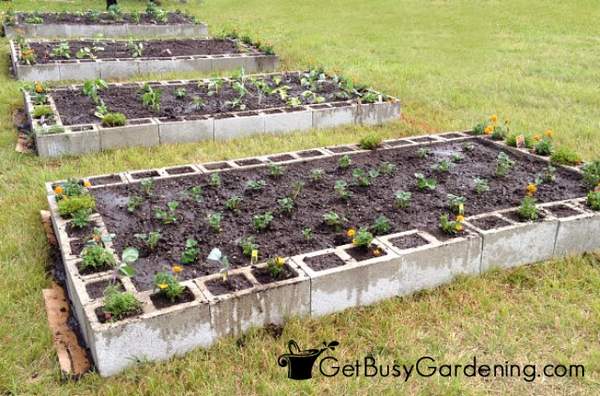
Are Cinder Blocks Safe For Raised Beds?
The short answer is “it depends”. Back in the olden days, these blocks were commonly made from ash, and that’s where the term “cinder block” comes from. But these days, they are made out of concrete and not cinder ash.
Because of the ash, old cinder blocks can leach chemicals into the soil, and you don’t want that if you’re growing vegetables. However, if you buy them brand new from the store, then they are most likely made from cement, which is safe to use for a garden.
If you want to be sure you’re building your beds out of concrete rather than true cinder blocks, then just ask the retailer before you buy them.
The two terms are used interchangeably, and “cinder block” is the more common one (heck, the sign at my local home improvement store says that on it, even though they are made with cement).
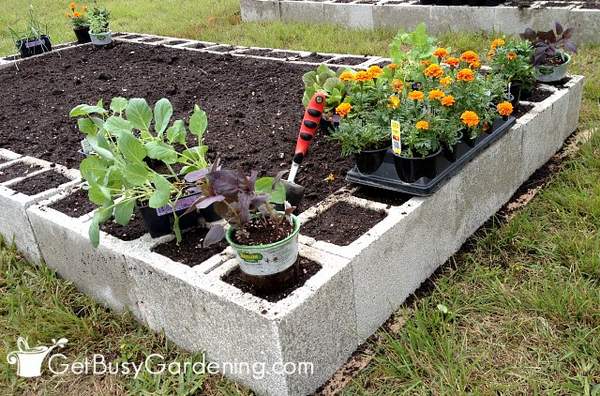
Tips For Building A Raised Garden Bed With Concrete Blocks
Building a raised bed with cinder blocks is pretty easy, but there are a few important steps you should take to ensure that they look great and fit into the space where you want to put them.
Choose The Location
First, you need to decide on a location. Be sure to choose a spot that is fairly level and gets plenty of sun (here’s how to figure out the sun exposure of your garden).
Then decide on how many cinder block garden beds you want to make. If you’re going to build more than one, you should allow plenty of space between them so that you can easily walk around and reach every corner. I recommend spacing them 2-4′ apart.
Proper spacing is even more important if you build them on top of the grass, and you need to be able to mow in between them.
Create Your Design
Since the blocks are square, and they are all the same size, designing your concrete block raised bed could not be any easier. All you need to do is measure the size of the space where you want to put it.
As you come up with your design plan, be sure to also think about how easy it will be to work in your beds. You don’t want them to be too wide, or it can be difficult to reach the middle.
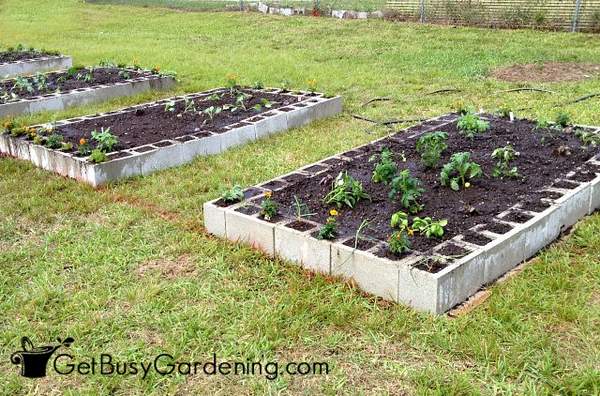
How Many Cinder Blocks Do I Need?
It’s super easy to figure out how many concrete blocks you’ll need for building a raised bed, because they are all the same size.
The blocks are 12″ (1 foot) long, which makes for really easy math. The beds we built (the ones in the photos) are 4′ x 7′, so we needed 20 cinder blocks to construct each one.
Once you determine how large your garden will be, it’s easy to figure out how many blocks you need to buy so you won’t have any left over.
The Best Soil To Use
As I mentioned above, cinder blocks are cheap – but buying the soil to fill your new garden bed will probably be your biggest expense for this project. I know it’s easy to think about pinching pennies here… but don’t.
When it comes to gardening, the quality of the soil is super important. It’s the foundation in which plants grow, and they simply cannot thrive in cheap fill dirt.
So, whatever you do, be sure to fill your beds with high quality soil. You can buy compost in bulk, or mix your own quality soil to save money.
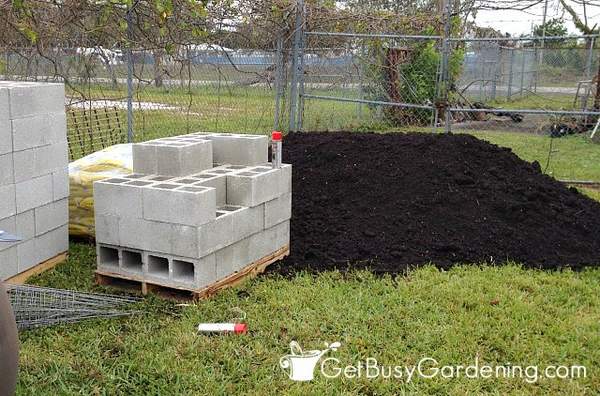
How To Build A Cinder Block Garden Bed
Below I’ll walk you through how to make these easy concrete block raised beds in your garden, step by step. Here are the supplies you’ll need, along with the detailed instructions:
Supplies Needed:
- Concrete cinder blocks
- Good quality garden soil
- Tape measure
- Work gloves
- Wheelbarrow
- Spade shovel
- Marking paint or spray paint (optional)
- Thick cardboard or newspaper (optional, use if you’re going over grass)
- Tamper tool (optional, needed for leveling the blocks)
- Level (optional, use if you want to make sure your blocks are level)
- Square garden spade (optional, use if you want to remove the sod under the blocks to level them)
Steps:
Step 1: Lay out your design – The first thing to do is to lay out the concrete blocks so that you can make sure everything fits into the space you have planned.
It’s much easier to move them around or change the design if you need to at this point than it will be later on in the project. Be sure to wear thick gloves when moving the blocks to protect your hands from the rough surface.
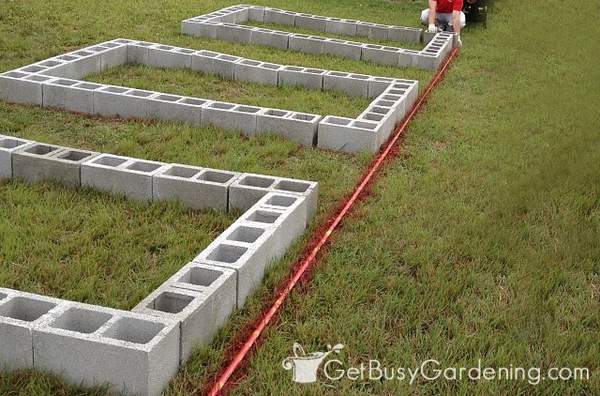
Step 2: Ensure the blocks are straight – Once you have the blocks laid out, use the tape measure to create a straight line.
Then mark the line using the marking paint. This line will act as a guide to ensure you’re keeping everything straight during the next steps.
Step 3: Remove the grass and level the blocks (optional) – If the area where you’re building your raised garden bed is fairly level, and the cinder blocks lay pretty flat, then you can skip this step if you want to.
But, if you’re putting it on top of your lawn, or the surface is uneven, then it’s a good idea to take the extra step to remove the grass so the blocks will sit level.
The blocks will settle over time regardless, but removing the grass will help to ensure they stay in place so your bed doesn’t become lopsided or uneven.
You don’t have to remove all of the grass, just the section that sits directly below the blocks. The grass in the center of the bed can remain in place.
To make it easy, use a square garden spade to dig out the sod. Then you can use a tamper tool to flatten the ground before laying the block, and a level to help you ensure they are straight.
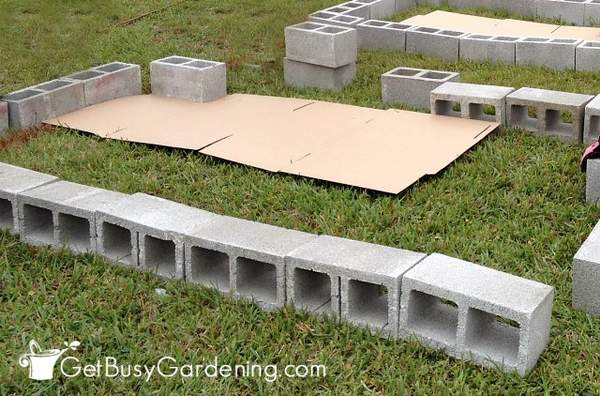
Step 4: Lay cardboard under the cinder blocks (optional) – This is another optional step, and not required if you’re building your concrete beds on top of soil or rock.
But, if you want to lay them right over the grass or weeds, then I highly recommend putting down a thick layer of cardboard first. This will smother the grass and keep it from growing into the beds.
If you don’t have cardboard, you can use a thick layer of newspaper instead (at least 10 sheets thick). Learn more about smothering weeds and creating a no dig garden bed here.
Step 5: Fill the bed with soil – Once you’re done building your beds, it’s time to fill them with soil. We found it easier to temporarily remove one block so that we could push the wheelbarrow into the bed, rather than trying to dump the soil over the top.
Don’t forget to fill the holes in blocks too, so you can use them as planters. If you don’t like that idea, then you can fill them with rocks or cheap dirt instead of garden soil, and then cover them with concrete retaining wall caps to give them a more finished look.
Just be sure to fill them with something to weigh them down and hold them in place, otherwise they can move around easier.
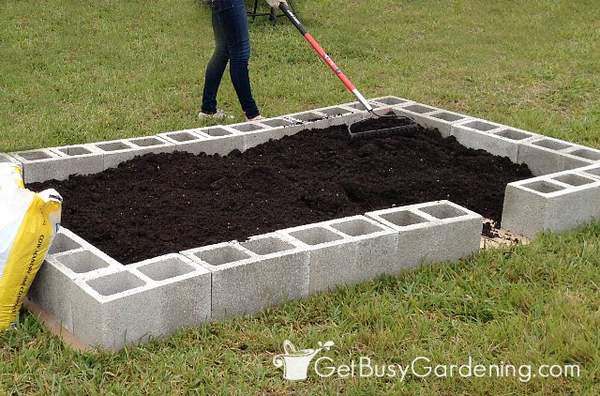
Step 6: Add the plants – Planting your new cinder block raised garden bed is the fun part. Just be sure to give it plenty of water after you’re done planting everything to give them a healthy start.
Also, keep in mind that the soil in your raised bed will settle over the first few days and weeks, so you may need to add more to fill in the holes and spaces.
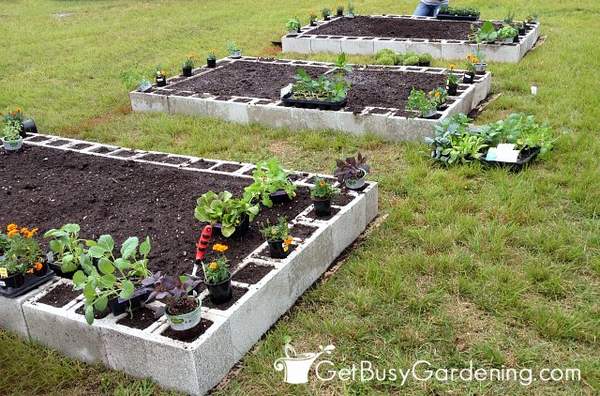
If you’re looking for a cheap and easy raised bed project, then building a cinder block garden is the perfect project for you.
Share your tips for building a concrete block raised bed garden in the comments below.
Print Out These Instructions
How To Build A Cinder Block Raised Bed

Anyone can build these concrete cinder block raised garden beds, it doesn't require any special skills. This easy DIY project takes only a few hours, and is very inexpensive - requiring only a few basic tools.
Materials
- Concrete cinder blocks
- Soil for raised beds
- Thick cardboard or newspaper (optional, use if you’re going over grass)
Tools
Instructions
- Lay out your design - Lay out your design to ensure the raised bed fits into the space. It's much easier to move the blocks around or change the design at this point than it will be later on. Be sure to wear gloves when moving the block.
- Ensure the blocks are straight - Once your design is laid out, use the tape measure to create a straight line, and mark it using the marking paint. This line will act as a guide to ensure everything is straight during the next steps.
- Remove the grass and level the blocks (optional) - If you're building on top of your lawn, or the area is uneven, it's a good idea to remove the grass so the blocks sit level. You don't have to remove all of the grass, just the section that sits directly underneath the blocks. To make it easier, use a square garden spade to remove the sod. Then you can use a tamper tool to even out the ground before laying the block, and a level to ensure the blocks are straight.
- Lay cardboard under the cinder blocks (optional) - This optional step is not required if you're building the raised bed on top of the soil. But if it's on top of the lawn, put down heavy cardboard to smother the grass. If you don't have cardboard, you can use a thick layer of newspaper (10 sheets thick).
- Fill the beds with soil - Once all of the blocks are in place, fill the bed with soil. If you're using a wheelbarrow, temporarily remove one block so that you can push it into the bed. Don't forget to fill the holes in the blocks with soil so you can use them as planters. If you don't want to do that, then fill them with rocks or cheap dirt instead. That will save you a few bucks, and prevent the blocks from moving.
- Plant your shiny new concrete block raised bed! This is the fun part. Once you're done planting, water your beds well. Keep in mind that the soil will settle over the first few days and weeks, so you may need to add more to fill in the spaces.
Notes
- Standard cinder blocks are 12" (1 foot) long, so you can easily do the math to figure out how many you will need to build each bed. (My beds are 4' x 7', which required 20 blocks per bed.)
- Even though they're commonly called "cinder blocks" most modern ones are made from concrete, which are non-toxic and safe to use in the garden.
- The concrete blocks are heavy, so make sure you are either strong enough to lift them on your own, or have someone who can help with the heavy lifting.
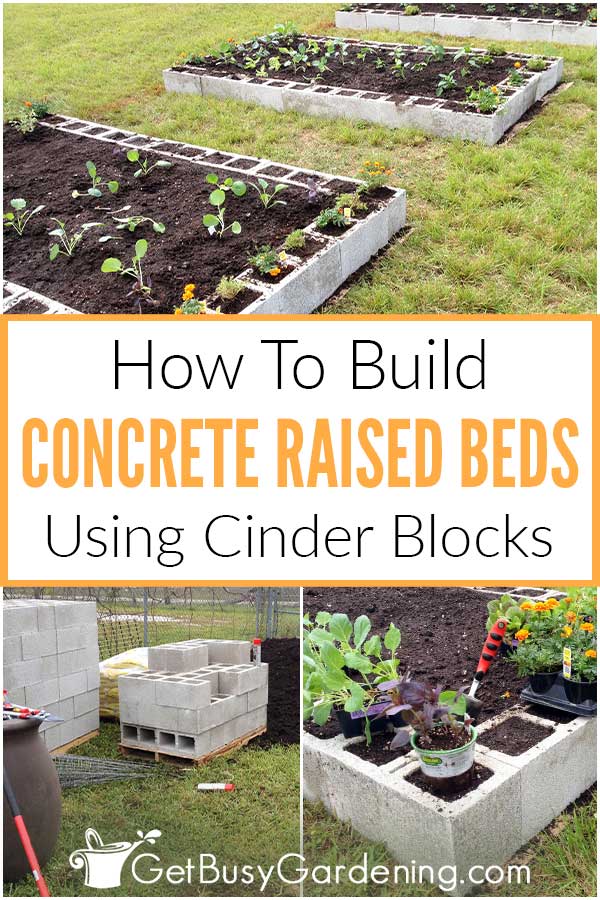
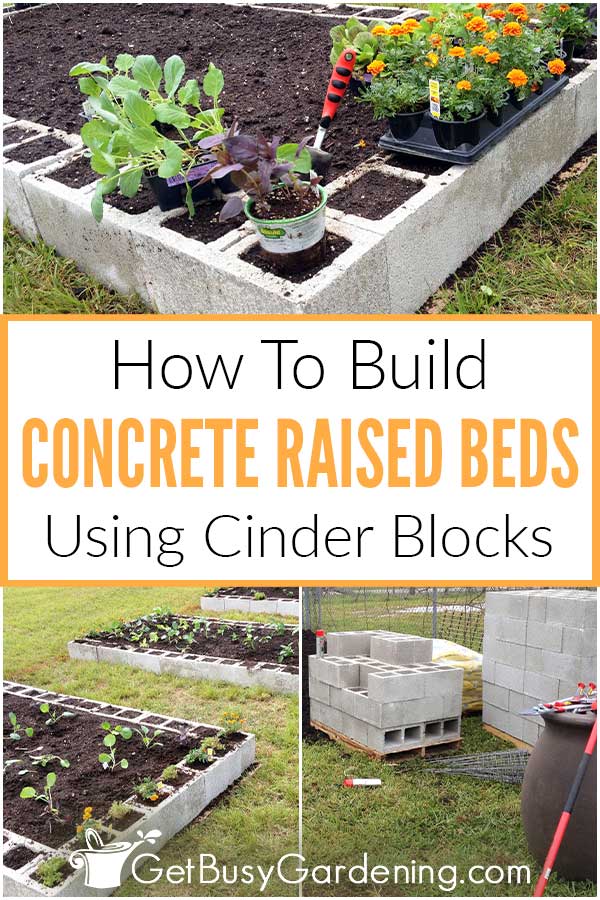
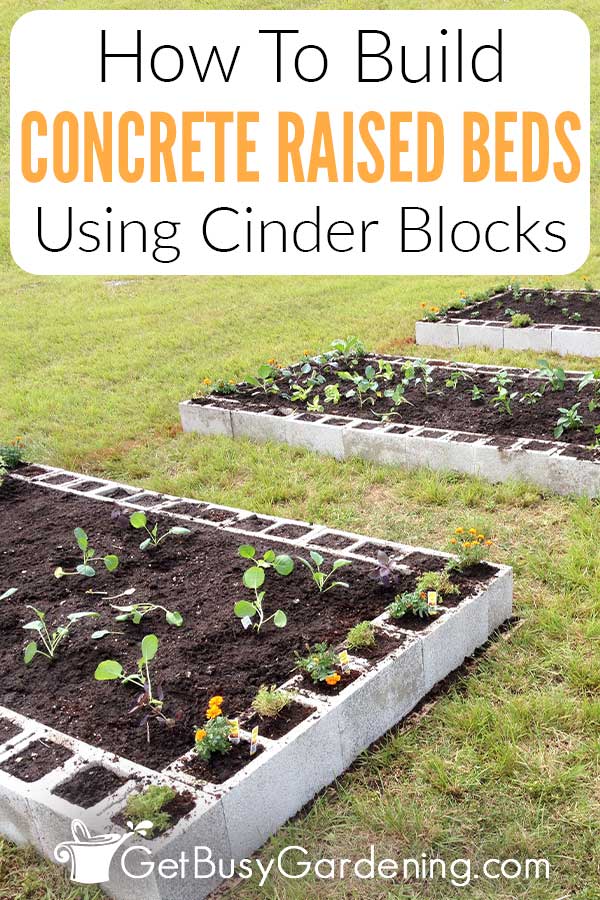
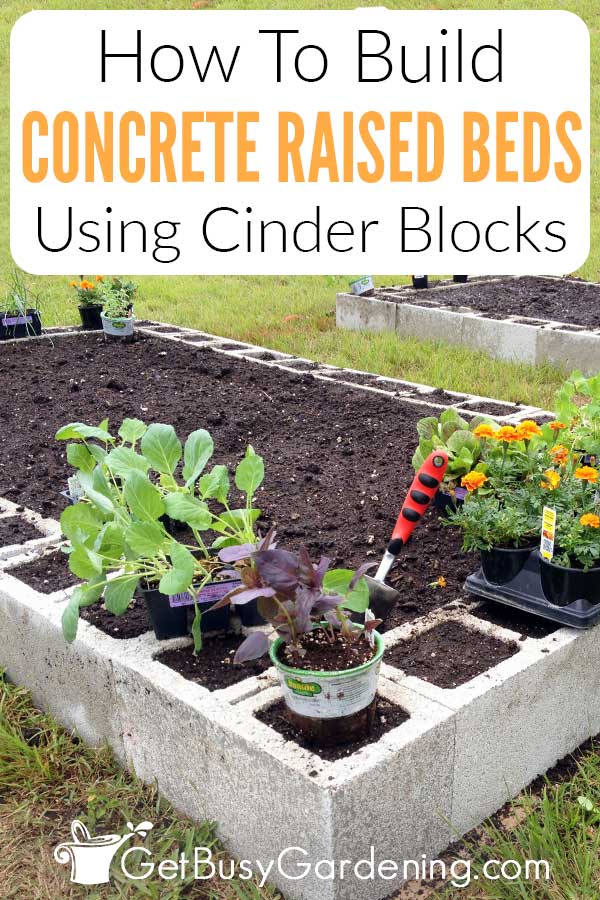
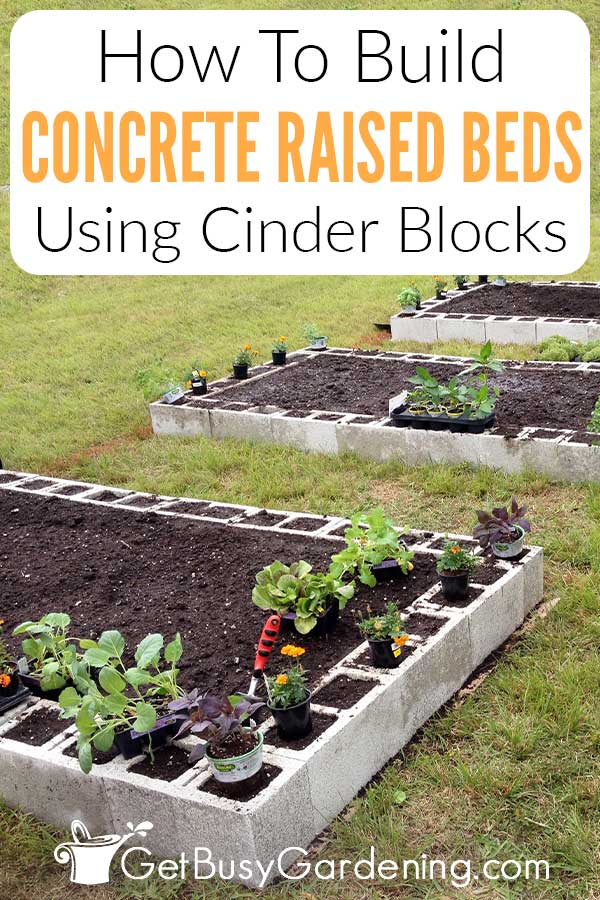
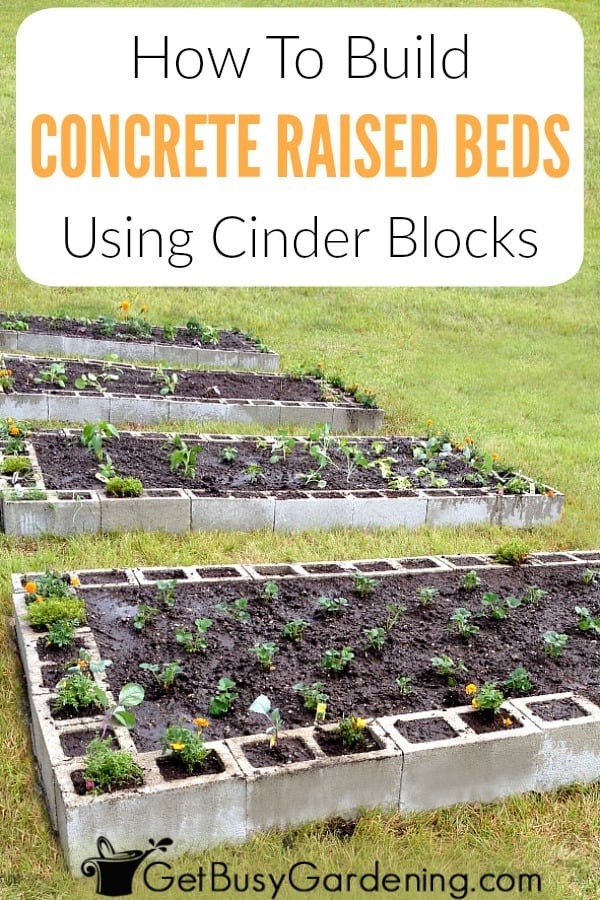
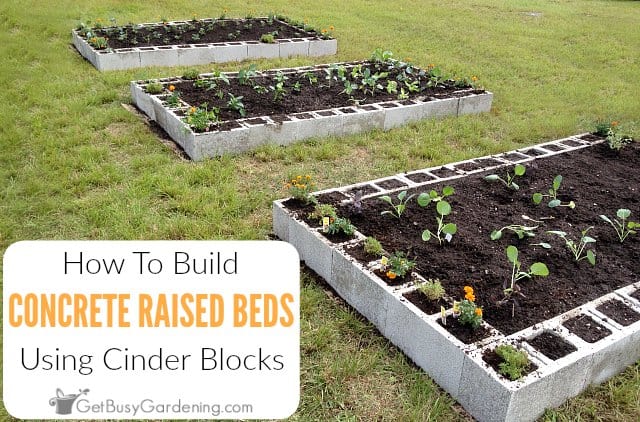


Susan Harper says
I have 4 concrete block raised beds. They hold the heat as well, so things planted in the holes grow bigger, like onions. Only one place of anything in the holes. You can also plant vine crops in the holes and they will spread out if you leave room between beds. I use cedar mulch between beds so I don’t have to mow and also keeps those vine crops dry so they don’t rot by lying on bare ground.
Amy Andrychowicz says
Sounds like you’ve had great success with your concrete block raised beds, thanks so much for sharing your experience and tips!
Phyllis says
These looks so good, & it is simple too! I really like the idea of planting herbs inside the blocks around the edge. We or rather, I have been wanting some raised beds for a long time, so now it looks to be very possible in the near future.
Probably in the Spring.
Amy Andrychowicz says
Awesome, hope you’ll be able to build one of your own soon!
Debby J says
Does the dirt in the concrete block holes dry out much faster causing the need to water more than usual?
Amy Andrychowicz says
Yes, the soil in the holes can dry out faster because the concrete tends to wick the water out. You can line them with plastic first (make sure to poke holes in the bottom) if you want, and that will help keep the moisture in longer.
Betty says
Amy, I didn’t read that you used the word “Cinderblock” even the Home Depot uses the term concrete blocks. People must be careful to read the exact wording on products.
Amy Andrychowicz says
Funny, the sign at my Home Depot says “cinder blocks” on it, LOL! Must be a regional thing. Don’t worry, the modern blocks do not contain cinder, they are made out of concrete which is totally safe to use for raised bed gardening.
Yvonne says
I love this idea and your s looks so nice but I thought you weren’t supposed to make planters out of these blocks. Something about bad things leaching into the soil. I hope this is not true because I just love your idea. Is there something special that has to be done to the blocks?
Amy Andrychowicz says
Yes, in the olden days they used to make this style of block out “cinder”, which is the material that can leach into the soil. But the blocks these days are made out of concrete, which is perfectly safe to use in the garden. So, as long as you use modern blocks, and not the super old ones, you’ll be fine.
William Fagan says
Have you heard or read anything about the dangers of Cinder Block and the poisons that might leach into the soil from them? I built mine and am now going to use Plastic to stop the leaching. I will put the plastic visqueen between the dirt and the cinder block. Thank you for the tips too. William
Amy Andrychowicz says
Yes, and I did cover the differences between cinder block and concrete blocks in the article above. As long as you use modern concrete blocks, and not super old ones, then you’re fine. They used to make these blocks out of cinder, which is the material that can leach into the soil. But they are made out of concrete these days. Though this style of blocks are still called “cinder blocks”, even though they no longer make them that way.
Sue Gilmore says
We put in a nice long concrete block raised bed in our yard 2 years ago. Someday, I hope it will be pavers, but my hubby loves the holes. We’ve had nice strawberries in them.
Amy Andrychowicz says
That’s wonderful Sue! We planted one of the concrete raised beds we built with strawberries too, I bet it looks beautiful once the strawberries fill in.
betonaloka says
Is it possible to build a garden with light cement blocks?
Amy Andrychowicz says
I have never tried using lightweight concrete blocks before, so I can’t speak from experience. But, if they are too lightweight, then they may not be able to hold the soil in place in a raised bed. I’m not sure how heavy the blocks are, so you may want to reinforce them with stakes or something similar to make sure they stay in place.
Katt says
I dont see where you’ve said how much soil was needed to nicely fill your 7×4bed….how many bags, or how much footage would I have to purchase?
Amy Andrychowicz says
For a concrete block raised bed of that size, you’ll need about 1 cubic yard of soil. You’d have to do the math to know how many bags that would equal, because it depends on the size of the bag.
Wendi says
I want to stack to be 3 blocks high to go around my entire patio (except for stairs). I don’t like the finished look the concrete guy left so I’m trying to hide the ugly. If I glue the blocks, would this hold? I was going to put the flat cinder type blocks on top for a finished look and perhaps paint them.
Amy Andrychowicz says
Sorry but I have never tried gluing concrete blocks together, so I have no idea how well that would hold. I would ask someone at the place where you plan to purchase them, they should know how best to reinforce them if you plan to stack them that high.
Craig says
If you can afford it you might consider hiring a contractor to terrace around your steps. It might not increase the value of your home but when you/ your child(ren) want to sell the house (eventually) it will improve its ascetic value down the road…
Van Nguyen says
Glue and steel rod diagonally in the hole may work.
Woosaw says
Hi, just got in an argument with my boyfriend. He wants to make a concrete raised bed at his parents’. I want to wait til we get our own place because it sounds like a lot of work. Are they as easy as he claims they are to build or is he just blowing smoke up my behind?
Amy Andrychowicz says
Yes, as far as raised beds go, they are easy to build. However, the concrete blocks are pretty heavy. Hauling them around is the hardest part for sure. But, if you have the muscle (hint: your boyfriend!), then they are super easy to make! 😉
Wendy says
Hi! Would it be ok to make a 3ft high by 3 w concrete block raised bed?? Or do u think that’s too high! I want it to plant tomatoes n veggies ! Thank u
Amy Andrychowicz says
I wouldn’t recommend stacking the concrete blocks without extra support of some kind. I don’t think they would hold all that dirt just being stacked on top of each other.
Craig says
If you plant indeterminate tomatoes you might not be able to reach the plant top without a ladder. Your local hardware store sells concrete in caulk tubes if you can’t make your own moarter, or use some concrete adhesive to bond the blocks together.
joe says
concrete blocks are great alternative to wood. however, I’ve found the garden seems to dry out a lot easier due to porous of the blocks generating a lot of heat. plant in a shaded area works good
Amy Andrychowicz says
Good point. Thanks for your added tips about growing in concrete block raised beds! 🙂
Donna McPherson says
If you put garden grade plastic under the blocks and wrap it up the inside side as well it will keep the blocks from drawing the water from the garden.
Craig says
Mulching helps hold moisture. Planting in the shade only works for shad loving plants; your ‘maters won’t make it…
Bridget says
I’d love a follow up post or instagram post once the garden is in full bloom. I might have a better chance of convincing my husband if I show him how it would look full and with the alyssum softening things up.
Amy Andrychowicz says
LOL! Unfortunately this was a community garden project that I helped with in Florida a few years ago so I don’t have any photos of it all filled in. But, if your husband doesn’t like the look of the cinder block planter holes, you can buy caps for the blocks that will cover the holes and give the raised bed a more finished look. The caps aren’t very expensive, and you should be able to find them wherever you buy the blocks.